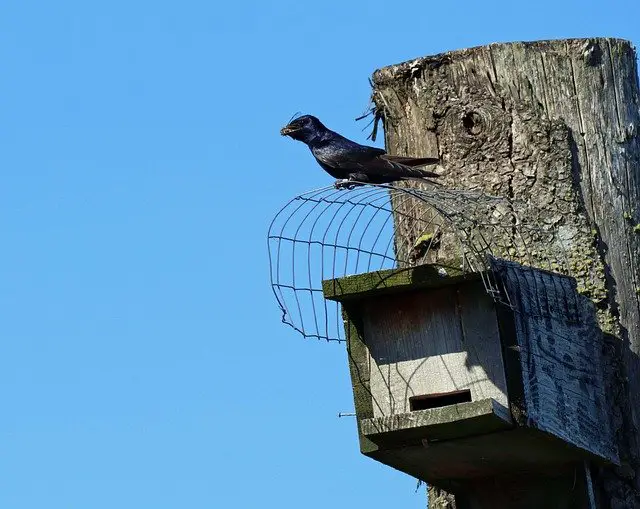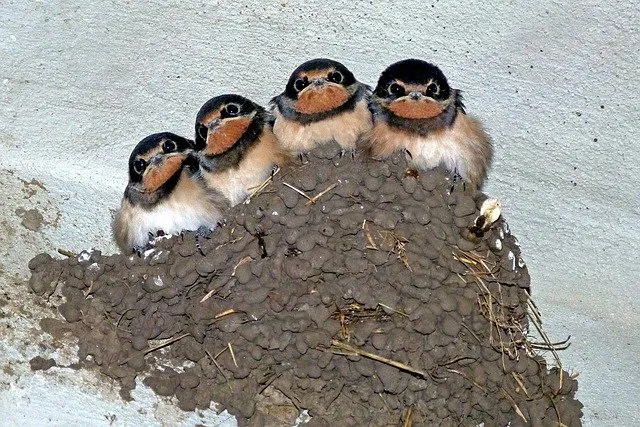As an Amazon Associate I earn from qualifying purchases.
Welcome to the enchanting world of purple martins, where vibrant plumage meets aerial acrobatics. These friendly and captivating birds have long been a subject of fascination for birdwatchers and nature enthusiasts alike. As aerial insectivores, purple martins play an essential role in maintaining the ecological balance by curbing insect populations. In this blog post, we embark on a journey to explore the dietary habits of these graceful creatures, uncovering the delightful array of delicacies that make up their daily meals. From skillful mid-air hunts to seasonal feeding frenzies, join us as we unravel the mysteries of “What Do Purple Martins Eat?” and gain a deeper appreciation for their vital role in our ecosystem.
What Do Purple Martins Eat?
Purple martins (Progne subis) are magnificent and sociable birds known for their vibrant plumage and delightful songs. Aerial insectivores play a crucial role in ecological balance by regulating insect populations. These creatures, known as aerial insectivores, are important in maintaining ecological balance by controlling insect populations. Understanding the dietary preferences of these beautiful birds can help us appreciate their importance in our ecosystem. In this blog post, we will explore the diverse foods that make up purple martin’s diet and shed light on their unique feeding habits.
1. Insects:
Insects form the primary food source for purple martins. These birds are skilled aerial hunters, and their diet relies heavily on the abundance of flying insects. Some of their favorite insect delicacies include:
a) Dragonflies:
These large, agile insects are often seen gliding above water bodies. Purple martins have developed exceptional agility to catch dragonflies mid-air, thanks to their swift flight and keen eyesight.
b) Mosquitoes:
As natural pest controllers, purple martins are famous for their voracious appetite for mosquitoes. Purple martins around human habitats can be highly beneficial, with mosquitoes being carriers of various diseases.
c) Beetles:
Purple martins actively hunt and consume various beetle species, from tiny aphids to larger beetles. They often take advantage of seasonal beetle swarms to satisfy their appetites.
2. Butterflies and Moths:
Butterflies and moths are also on the menu for purple martins. The birds will gracefully glide through the air to snatch these insects mid-flight. Their preference for certain butterfly species, such as the cabbage white butterfly, may be influenced by their abundance in specific regions and seasons.
3. Flying Ants:
During certain times of the year, flying ants form a significant portion of the purple martin’s diet. These birds will gather in large flocks to feast on flying ant swarms. This feeding frenzy can provide a captivating spectacle for birdwatchers.
4. Flying Termites:
Like flying ants, flying termites are seasonal treats for purple martins. When termite swarms take flight, purple martins capitalize on the opportunity to indulge in these protein-rich insects.
5. Flies:
Flies of various species are abundant and accessible to purple martins, making them a convenient source of nutrition. The birds are skilled at catching flies in mid-air, showcasing their exceptional flying abilities.
6. Grasshoppers and Crickets:
Purple martins are not picky eaters regarding large insects like grasshoppers and crickets. These hopping insects provide valuable nutrients to the birds, especially during breeding and molting seasons.
7. Other Flying Invertebrates:
Purple martins occasionally dine on flying invertebrates, such as ants, wasps, and flying beetles. Their diet is adaptable to the availability of these food sources in their specific habitats.
How to Do Purple Martins Hunt?
Purple martins are skilled aerial hunters, and their hunting techniques are a marvel. Their entire foraging process revolves around their exceptional flying abilities, keen eyesight, and agile maneuvering. Here’s how purple martins hunt:
1. Aerial Foraging:
Purple martins spend much time in flight, capturing insects on the wing. They are highly maneuverable birds with long, pointed wings that enable them to perform agile aerial maneuvers effortlessly. This aerial prowess allows them to cover vast areas while hunting for prey.
2. Scan and Pursue:
While flying, purple martins continuously scan the skies and surroundings for potential prey items. Their keen eyesight helps them detect tiny insects from considerable distances. Once they spot a suitable target, they lock onto it with precision.
3. Mid-Air Snatching:
Once a target is identified, purple martins engage in swift, targeted flights to close the gap between them and their prey. They are capable of sudden and rapid changes in direction, allowing them to adjust their flight path accurately to intercept their prey in mid-air.
4. Scoop and Swallow:
Purple martins use a “scoop and swallow” technique to catch their prey. Purple martins use a “scoop and swallow” technique to catch their prey. As they approach the insect, they open their beaks wide and scoop up the target with gaping mouths. This technique allows them to catch insects on the wing with great efficiency.
5. Returning to Perches:
After successfully catching their prey, purple martins often return to a perch or their nest to consume the captured insects. This behavior is particularly common during the breeding season when they bring food to their hungry chicks in the nest.
6. Group Foraging:
Purple martins are highly social birds and often forage in groups. They can be seen flying and hunting together, especially during insect swarms. This group’s foraging behavior allows them to use abundant food sources efficiently.
7. Seasonal Variations:
The purple martin’s hunting behavior can vary throughout the year, depending on the availability of insect species. During the breeding season, they may focus on catching larger insects to provide more substantial meals for their growing chicks. In contrast, during migration, they might target smaller insects that are more readily available.
How Do Purple Martins Help Our Ecosystem?
Purple martins benefit our ecosystem due to their ecological roles and contributions. As aerial insectivores, these birds provide numerous advantages that positively impact the environment and human populations. Here are some ways in which purple martins help our ecosystem:
1. Natural Pest Control:
One of the most significant contributions of purple martins is their role as natural pest controllers. Their diet primarily consists of flying insects, including mosquitoes, flies, beetles, moths, and other pests. By consuming large quantities of these insects daily, purple martins help regulate their populations, reducing the need for chemical insecticides and promoting a more balanced ecosystem.
2. Controlling Disease Vectors:
Mosquitoes are carriers of various diseases, including malaria, Zika, and West Nile. Purple martins are especially effective in reducing mosquito populations, thus indirectly helping to control the spread of these diseases to humans and other animals.
3. Seed Dispersal:
While the primary diet of purple martins consists of insects, they occasionally consume fruits and berries. The seeds pass through their digestive system when they eat these fruits and are later dispersed through their droppings. This process aids seed dispersal and contributes to plant diversity and regeneration in different habitats.
4. Pollination:
Though not their primary role, purple martins may inadvertently contribute to pollination by visiting flowers while foraging for insects. While they are less efficient than specialized pollinators, such as bees and butterflies, their occasional flower visits can assist plant reproduction.
5. Ecological Indicators:
Purple martins can serve as indicators of the health of their ecosystems. Their presence and breeding success can reflect the environment’s overall health, including the availability of food sources and suitable nesting habitats. Monitoring purple martin populations can help researchers assess the impact of environmental changes on local ecosystems.
6.Ecotourism and Education:
Purple martins are beloved by birdwatchers and nature enthusiasts, contributing to ecotourism in regions where they breed and migrate. Birdwatching activities centered around purple martin colonies can benefit local communities economically. Additionally, their presence provides an excellent educational opportunity for people to learn about bird conservation and the importance of preserving natural habitats.
Final Words
In conclusion, exploring purple martins’ dietary habits and hunting techniques has revealed the indispensable role these enchanting birds play in our ecosystem. Their adeptness at aerial hunting and their voracious appetite for insects make them natural pest controllers, reducing insect populations and curbing the spread of disease vectors like mosquitoes. Moreover, their contribution to seed dispersal and occasional involvement in pollination further highlights their importance in maintaining biodiversity. As we continue to cherish and protect these beautiful creatures, we embrace a sustainable future where purple martins thrive and our ecosystem flourishes in harmony with nature’s intricate balance. Let us celebrate the remarkable role of purple martins, appreciating their invaluable gifts to the world of avian wonders.
You can also read:
1.What Do Puffins Eat? A Culinary Adventure
2.WHAT DO PRAIRIE DOGS EAT? A DELECTABLE GASTRONOMIC ADVENTURE
3.The Fascinating World of Oriol Diets: What Do Orioles Eat?
4.WHAT DO NIGHTCRAWLERS EAT? THEIR CULINARY JOURNEY
Amazon and the Amazon logo are trademarks of Amazon.com, Inc, or its affiliates.



